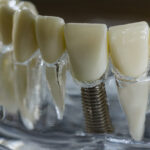In a dental implants overview, we explore how these restorations are revolutionizing smiles. Dental implants are one of the most popular methods for restoring missing, lost, or decayed teeth. With the help of implant dentistry, individuals who have lost or are missing teeth can receive permanent dental replacements that can seamlessly blend in with their natural smile and restore the functionality of the teeth. Implant-supported restorations are not only aesthetically pleasing but also offer a variety of benefits for patients.
What Are Dental Implants?
Dental implants are titanium screws shaped like tooth roots that are embedded in the jawbone to replace lost or missing teeth. The screw is securely placed in the jawbone and acts as a stable base for a natural-looking artificial tooth or bridge.
Dental implants often look and feel like natural teeth and can be placed as single tooth replacements or used to support dentures. When the procedure is complete, daily oral hygiene maintenance, including flossing and brushing, is the same as it is for natural teeth.
What Are the Two Main Types of Dental Implants?
There are two main types of dental implants that offer different solutions depending on the patient’s individual needs and bone structure. The specific type of implant used will be determined by the dentist or oral surgeon after a thorough evaluation of the patient’s oral health and treatment requirements.
-
Endosteal Implants
These implants are placed directly into the jawbone. They are typically made of titanium and resemble small screws or cylinders. Endosteal implants provide a strong foundation for artificial teeth, such as crowns or dentures. This type of implant is the most commonly used and is suitable for patients with sufficient bone density.
-
Subperiosteal Implants
Unlike endosteal implants, subperiosteal implants are placed on or above the jawbone but beneath the gum tissue. They consist of a metal framework with posts that protrude through the gums to hold artificial teeth. Subperiosteal implants are used when the patient does not have adequate bone height or density to support traditional implants. This type of implant is less commonly used compared to endosteal implants.
Due to the continuous development of dental technology, new types of implants are constantly being introduced to cater to evolving patient needs. Exploring these innovations will provide you with a more comprehensive understanding of the additional implant options available, along with their distinct features and the specific situations where they are most suitable.
What Are the Key Benefits of Dental Implants?
Dental implants offer a number of unique benefits for patients. Some of the key benefits of teeth implants include:
- A natural appearance: Dental implants provide a natural-looking solution for replacing missing teeth. They have a similar appearance to natural teeth, and no one will be able to tell the difference.
- A return to chewing function: Dental implants provide a stable solution for replacing missing teeth and allow patients to return to eating the foods they enjoy.
- Easy dental care: With dental implants, there is no need for extra cleaning. Dental implants require the same daily oral hygiene maintenance as natural teeth, including brushing, flossing, and regular checkups.
These are just some of the advantages that dental implants offer. There is much more to discover about the positive impact of dental implants on oral health, aesthetics, and overall well-being.
Dental Implants Overview
Dental implants have established themselves as a safe and widely accepted standard of care for replacing missing teeth. The techniques involved in implant placement have undergone extensive refinement over several decades. Notably, the remarkable 98% success rate of dental implants can be attributed to meticulous planning tailored to each patient’s specific needs, ensuring their overall health and ability to undergo the dental surgery while facilitating proper healing and recovery.
Instances of failed implants are exceedingly rare and typically stem from exceptional circumstances such as excessive strain on the implant, implant fracture, infection, damage to surrounding tissues, compromised bone quality, or improper implant positioning. However, with a diligently planned procedure led by a qualified dentist, these risks can be effectively mitigated. It is crucial to recognize that implant failures, should they occur, are highly individualized situations that warrant personalized evaluation for the most suitable resolution.
If you’re considering getting dental implants, there are several important factors to keep in mind. It is also important to consult with a qualified dentist to discuss your options. They can help you determine if you’re a good candidate for dental implants and explain the different types of implants available and the procedure involved. By educating yourself, considering these factors, and partnering with a trusted dental professional, you can confidently navigate the journey towards achieving a restored smile and improved quality of life through dental implants.
For more information on dental implants in Madison NJ and to find out the cost of your individual treatment, please contact us today or call 973-822-8003.




